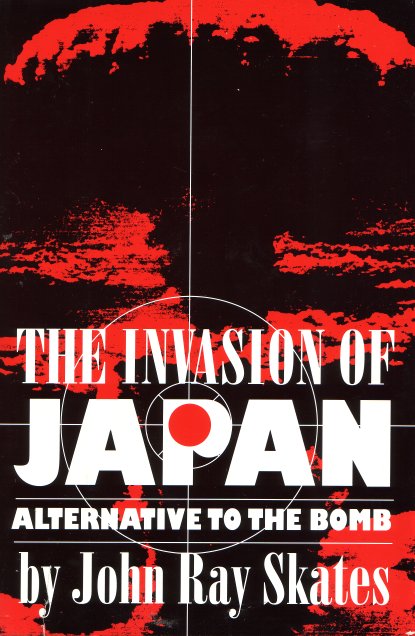
The Invasion of Japan

This book (which is very good and very detailed) is about the proposed invasion of the Japanese mainland during World War II, something that was actually planned out and ready to be used, only to be stopped by the surrender of Japan after the atomic bombing of two of the country's cities.
Again, as with other books, I will only note some of the highlights.
The book talks about the mining campaign and just how successful that was, even though it's something that most people are not familiar with. The book notes that in May, 1945, more Japanese shipping was sunk by mines than by submarines. The program basically blocked off almost all the Japanese ports, and the program was extended into Korea to block Japanese shipping there. '
One of the programs that was not used, but was considered as a possibility, was a program to spray the Japanese rice crops with chemicals that would kill them, cutting down the already low amount of food available to the Japanese.
A program I hadn't seen discussed elsewhere was Project Aphrodite, or Weary-Willie. Old B-17's that had been pretty much used up would be loaded with explosives and flown by remote control to dive into enemy targets that were too tough for regular bombing to destroy. The program never really got very far.
Another program was the JB-2, which was really a modified version of the German V-1 buzz bomb. The plan was to launch 48 of these each day for sixty days, but that program was also stopped when it was decided that the targets within range had already been pretty much destroyed by the fire-bombing campaign. However, the program could still have been used on days of bad weather when regular planes couldn't fly, but the JB-2s could.
A program for the use of poison gas was also readied for Operation Olympic, the gas to be used against Japanese troops held up in caves.
The book goes into the subject of just why such weapons were going to be used, relating this, basically, to how much hatred there was of the Japanese during that time. The Japanese atrocities during the war, and just the fact that they continued to fight and kill so many Americans when it was obvious to everyone that they were going to lose the war, caused a lot of Americans to believe that anything was justified as far as defeating the Japanese went.
The book discusses Operation Olympic in detail, but it also discusses the Japanese plan to meet that attack, noting that the Japanese already pretty well knew where the attacks would come and in what strengths, and they had tried to prepare their defenses accordingly.
The book, and other sources, holds that the deadliest weapon the Japanese had at this point in the war was the use of kamikazes, including planes, boats, subs, humans carrying bombs, etc. Should the invasion have occurred, there is no doubt that the intensity of the kamikaze attacks would have been greater than anything seen so far in the war.
The attacks were going to be mainly on the transports carrying the troops rather than the ships, thinking that this approach would kill the most men the quickest. The Japanese had planned to use around 5,000 kamikaze planes during the first ten days of the invasion alone. They also had around 2,000 small suicide boats, called shinyo. They had lots of midget submarines in addition to the boats. American planners figured they could lost perhaps 20% of their forces even before they managed to set foot on Japanese soil, the kamikaze attacks would have been so strong.
The book also talks about the oka bombs, or baka bombs, the rocket-propelled suicide craft. They had the advantage of incredible speed, making them much, much harder to shoot down once they were on target, but they had the major disadvantage of having to be carried into battle by large planes called Bettys, and those planes were relatively slow and fairly easy to shoot down.
The Japanese would also have regular attack planes in their defense, hoping that the combination of those with kamikaze planes would inflict major losses on the Americans.
As far as the issue of use of civilians goes, the book holds that the plan was to evacuate civilians to rear areas, and just use civilians in construction, supply and agricultural uses.
The book presents its analysis of the overall situation of the possible results of an invasion. It says that, although the plans on paper for Japan were very good, that the actual plans were not complete by the time of the projected invasion, and that “communication, supplies, and transportation were woefully inadequate.”
The roads in the area were not prepared for military traffic. Many of the bridges were of logs, and the railroads could have been neutralized by bombing any of the many tunnels that they went through. There was not an adequate supply of ammunition. The American bombardment and bombing prior to the actual invasion could have made things so bad as far as transportation and communication goes that the Japanese might not have been able to move units into areas where they were needed.
The book also holds that civilians would not have been used as suicide squads or bamboo-wielding troops.
The book holds that the dead would have been 15,000 to 20,000 American troops, plus another 50,000 or so wounded. The book also says that if Operation Olympic had been successful, Operation Coronet, the invasion of the Tokyo area, would not have been necessary as the Japanese would have surrendered or, if it did take place, it would not have been very bad since the Japanese would not have had any resources left, having planned to use all their military and kamikaze might in Kyushu.
Main Index
Japan main page
Japanese-American Internment Camps index page
Japan and World War II index page
|